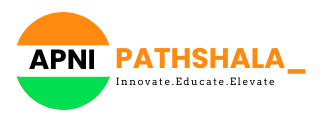“Success is not the key to happiness. Happiness is the key to success. If you love what you are doing, you will be successful.”
–Albert Schweitzer
Introduction
Setting up a successful Apni Pathshala Pod can be a transformative journey, not just for the children involved but for pod leaders and the entire community. There’s no one-size-fits-all approach to success; each pod is unique, shaped by its own objectives.
Think of it this way: If your pod meets the goals you set for it, then it’s successful. With over 50 active pods across various communities in India, Apni Pathshala is empowering learners to achieve their own unique goals, whether it’s problem-solving, boosting digital literacy, or even providing job training.
What is an Apni Pathshala Pod?
An Apni Pathshala Pod is a community-based learning hub where students can learn, grow and connect in a focused environment. Each pod has its objective whether it’s enhancing digital skills, fostering creativity, or addressing specific community needs. The beauty of these pods is that they adapt to the community they serve, making success metrics highly personalized.
Understanding Your Objective
Creating a supportive environment is the backbone of a successful Apni Pathshala Pod. It’s not just about the curriculum or the objectives; it’s about building a space where students feel safe, valued, and motivated to learn. Here’s how you can build such an environment:
- Building Trust and Relationship
To build a successful pod, it’s essential to create a safe and nurturing environment. This involves:
- Strong Relationships: Building trust with students and parents establishes a foundation for effective learning. Open communication channels are critical for feedback and growth.
- Encouraging Participation: Involve students and parents in decision-making. This democratic approach encourages ownership and responsibility are key elements in the learning pod’s success.
- Delivering Personal Attention
Consider breaking down the group into smaller sessions that focus on specific skills or challenges. This way, you can give each student the attention they need. Maybe some students need extra help with a particular concept, while others are ready to dive into more advanced material. By catering to these needs, you make the learning experience more relevant and rewarding for everyone involved.
- Selecting the Right Curriculum
Choosing the right curriculum is crucial for your pod’s success. Look for programs that align with your objectives
- For Digital Literacy: Choosing curricula that introduce essential computer skills and internet safety. Many platforms offer free resources to get you started
- For Soft Skills Development: Incorporate modules on communication, teamwork, and problem-solving
Your curriculum should not only meet educational standards but also resonate with the needs of your students.
How to Build a Supportive Environment in Pods?
- Why is Defining Objective Important?
Before you start your pod, it’s crucial to understand and define clear objectives. Think of your pod as a ship. Without a clear destination, it will just drift at sea. Your pod’s purpose is like a sail, guiding it toward the goal.
For instance, if your Pod aims to solve a specific problem – say, enhancing digital literacy for teens – your success can be measured by how well your community is learning and utilizing these skills. This can be done by tracking the participants who complete online courses or even those who secure jobs in digital fields post-training.
- What are these Metrics for Success?
Success looks different for every Apni Pathshala Pod because each pod has its own unique objectives. Think of it like this: success for one pod might mean helping students land their first jobs, while another pod might measure success by how well its students improve their digital skills.
So, how do you know if your pod is on the right track? Here are a few key metrics to help you gauge success:
- Job Creation: If your pod’s main goal is to help students find jobs, you’ll want to track how many students secure employment after going through your training. Did you manage to get some students into internships or full-time roles? That’s a big win. The more students you help launch into their careers, the more successful your pod is.
- Skills Development: Maybe your focus is on boosting digital literacy. In that case, success is all about the progress your students make. Start by assessing their skills at the beginning of the program and then compare those results with where they stand at the end. Are they more confident using technology? Are they able to complete tasks that were challenging before? Tracking this improvement will show you how effective your pod’s training has been.
- Long-Term Impact: Finally, think about the long-term effects. Are your students applying what they’ve learned in real-world situations? Are they continuing to grow even after the pod ends? Keeping in touch with former students and tracking their ongoing progress can give you insight into the lasting impact of your efforts.
These metrics will help you assess how well you are achieving your objectives.
How can I make my Pod Successful?

Measuring success for each Apni Pathshala Pod can be highly focused, as each pod operates with its unique objectives and goals. Here are some tailored ways to assess the effectiveness and success of a Pod, based on various focus areas.
- Define Clear Objectives
Success begins with clear objectives. Each Pod should articulate its purpose, whether that’s enhancing digital literacy providing job training, or solving specific community challenges.
Example: A Pod focused on job training might set an objective to help 30 students secure internships within one academic year
- Feedbacks and Surveys
Regularly gather feedback from participants, parents, and community members to understand the perceptions of the Pod’s effectiveness.
Example: Running a survey at the end of each term can help pods evaluate satisfaction levels, what skills were gained, and areas needing improvement.
- Tracking Progress Over Time
Monitor students’ continued progress to see if the skills learned are being applied. This could involve regular follow-ups.
Example: For a Pod focused on vocational training, tracking how many students secure jobs in their trained fields over a set period following their participation.
- Success Stories and Testimonials
Collect success stories from students who have benefitted from the Pod. These narratives can provide qualitative measurements of success and highlight the Pod’s impact.
Example: A student might share how the coding skills learned in the Pod helped them land a tech internship or fix their family’s IT issues.
- Community Impact
Understand how well the Pod is serving its community. This could involve looking at broader metrics, such as community engagement with local businesses.
Example: If a Pod fosters connections with local industries leading to job placements, this can be a significant indicator of community impact and success.
- Job Placement Rates
For Pods focused on career-oriented objectives, measuring job placement rates can serve as a powerful success metric.
Example: Track the number of students who secure internships or jobs shortly after completing Pod activities related to career readiness.
- Skill Acquisition Benchmarks
Make use of pre-and post-assessments to quantify skill improvement. This method allows for a clear measurement of what students have learned and how they’ve grown.
Example: After completing a digital literacy course, students can test to measure their capabilities against skill levels.
- Engagement Levels
Measure student participation and engagement throughout the Pod’s activities. Higher levels of enthusiasm typically correlate with a successful learning experience.
Example: Track attendance records or participation rates in workshops and discussions, noting increases over time.
- Long-Term Outcomes
Evaluate the long-term effects on students post-Pod. Successful Pods will have students who continue to apply what they’ve learned long after their participation.
Example: Conduct follow-up assessments or surveys a year later to see if students are still using the skills they gained.
Conclusion
The measure of success in an Apni Pathshala Pod isn’t a one-size-fits-all formula; it’s about aligning metrics with the specific goals of each pod. By establishing clear objectives, using diverse metrics, and continuously engaging with students, each pod can measure its success and make decisions for improvement. Engaging with students and the community continuously fosters growth, ensuring that Pods remain relevant as they aim towards their unique missions.

